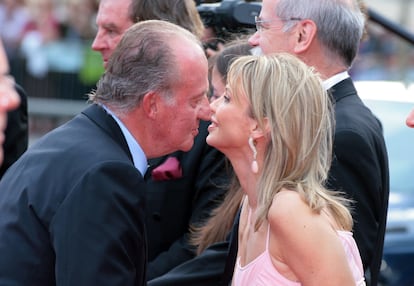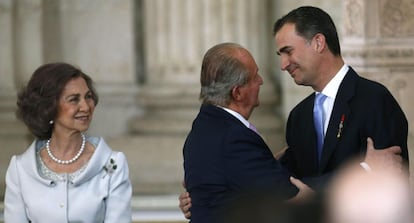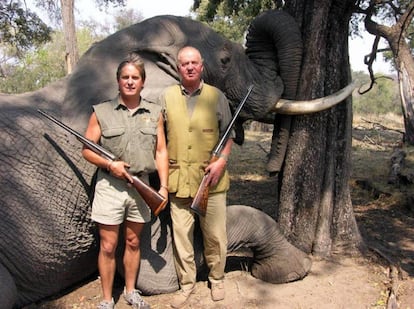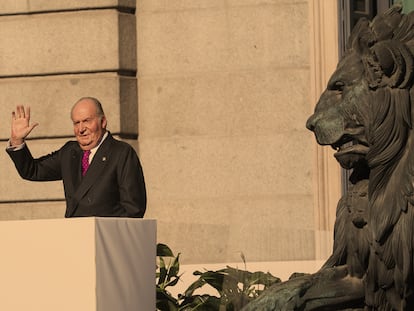How former Spanish king Juan Carlos I’s affair with Corinna Larsen turned into ‘a matter of state’
The former monarch consulted a specialist law firm about the possibility of officially splitting from Queen Sofía, sources say, but his relationship with the Monaco-based business consultant ended badly and both are now facing legal troubles


It was Corinna Larsen, a Monaco-based business consultant known for her relationship with Spain’s former monarch Juan Carlos I, who first talked in public about marriage. In statements to the BBC in August of last year, she asserted that her father told her in 2009 that Juan Carlos had asked him for her hand. “He called me up and said the king had come to see him and told him he was very much in love with me, and intended to marry me,” she said in that interview. “He also told my father he couldn’t do it straight away, it might take some time. He wanted my father to know he was very serious about me.”
Larsen added that she foresaw the situation could create trouble at a time when Juan Carlos was still on the throne (he abdicated in June 2014). “I thought it might destabilise the monarchy. That’s why I never really encouraged it – I just took it as a token of the seriousness of the relationship, rather than something that would actually materialize,” she told the BBC.
Finn Bönning Larsen, her father, died that same year, so only the emeritus king himself could certify whether indeed he asked for her hand. Sources close to Juan Carlos say it was the other way around: that the Danish-German divorcée was pressuring him to break up with Spain’s Queen Sofía and formalize their relationship.

The Spanish king’s lover had divorced her second husband, the German aristocrat Casimir zu Sayn-Wittgenstein, in 2005. Yet she continued to use his name and the title of princess. However, this situation became untenable when her ex became romantically involved with the US model Alana Bunte, whom he married in 2019.
A source who was a high-placed government official at the time admits that Juan Carlos was quite devoted to Larsen and was making plans to spend the rest of his life with her. If so, the €65 million that he transferred to her in 2012, using money he received from the king of Saudi Arabia, should be construed not as a generous “gift of gratitude” as Larsen herself has described it, but as a transfer for the couple to use in their future life together. When they broke up, she refused to return the money.
That relationship was quite different from the other affairs that Juan Carlos had conducted. The same sources say that the former king even consulted a law firm specializing in divorce proceedings about the possibility of ending his marriage of over 40 years. But he never made any steps in that direction, said the same sources, calling that scenario nothing more than a dream, “or more like a nightmare.”
The Royal Palace can be used for a Middle East peace conference, but not to help a lady make moneyFormer Spanish Socialist Party minister
Even if Juan Carlos had decided to give up the throne to marry her, and Larsen never actually got to be queen of Spain, the divorce would have caused a national stir. Alarm bells started to go off in the government during the last term in office of former Socialist Party (PSOE) prime minister José Luis Rodríguez Zapatero and the first administration of Popular Party (PP) prime minister Mariano Rajoy. The king’s relationship with the former German princess was starting to be considered a “matter of state.”
Several former ministers consulted by this newspaper, from the PP and the PSOE alike, confirmed that the government was concerned. “Corinna was not the first. The king has had several partners, all very discreet women who were aware that their conduct could hurt the institution,” said a source who served as a minister under Rajoy. “Corinna broke that pattern. She started to use him to do business, and that set off alarm bells in the government.”
A former PSOE minister said that in 2006, Larsen attempted to use the Spanish Royal Palace as a venue for a global conference on forged luxury goods: “The Royal Palace can be used for a Middle East peace conference, but not to help a lady make money. When she saw there was no future here from the point of view of influence management, she focused her business abroad.”
Hunting trip
Events snowballed after Juan Carlos’ accident on a hunting trip in Botswana on April 13, 2012, when he fell and broke his hip during an elephant-shooting expedition. During the flight back, with a badly hurt Juan Carlos on board, Larsen asked for the plane to make a stop in Monaco to let her off, a request that triggered a confrontation with the Spanish Royal Household. The aircraft flew directly to Madrid carrying the king and her lover, and the relationship became public. Juan Carlos’ popularity began to fall in the middle of a sharp economic crisis in Spain.
Less than a month after that, on May 5, 2012, the head of Spain’s National Intelligence Center (CNI) at the time, General Félix Sanz Roldán, traveled to London to meet with Larsen at a hotel. In videoconference testimony at a recent trial against José Manuel Villarejo, a former Spanish police chief who made secret recordings of his dealings with politicians and business leaders, Larsen said that Sanz had threatened her at the hotel meeting. Sanz has denied this claim.
Whatever it was that the CNI chief told her, it did not convince her to end her relationship with the Spanish monarch. According to sources close to the emeritus king, the relationship continued for two more years, with ups and downs.

But there was a turning point on January 6, 2014. Juan Carlos was reading a speech for the annual military parade, the Pascua Militar, and he suddenly seemed to lose track of what he was saying. The incident was attributed to his poor health and the string of surgeries that he had undergone. But it is likely that he was just tired: the king had spent the night before – his birthday – in London with Larsen, and he had barely slept a wink.
That image of the king stumbling over his speech reignited an ongoing debate about his abdication. The monarch was divided about the issue. And sources familiar with the situation say that Larsen was one of the people pressuring him the most to stay on the throne.
On June 2, 2014, Juan Carlos finally announced that he was handing the throne to his son Felipe VI. But just as he was gaining added freedom to live his life the way he wanted to, the 11-year-old relationship with Larsen came to a definitive end.
In April 2015, Larsen met in London with the former CEO of Spanish telecoms giant Telefónica, Juan Villalonga, and with the retired police chief José Manuel Villarejo. It was here that the latter recorded a conversation that he would later use against Juan Carlos, in which Larsen claimed that the former monarch had used her as a front to conceal his wealth. Sanz Roldán filed a defamation suit against Villarejo for saying that the ex-CNI chief had threatened the king’s former lover. The trial took place in January and Villarejo was acquitted.
What had happened in such a short space of time for the former German princess to turn against someone who had been so generous to her? Sources who were close to the government at the time say that after Juan Carlos and Larsen broke up, the Spanish executive made a point of notifying foreign dignitaries and business leaders about it. This led to a lot of closed doors that had once been open for Larsen thanks to her close connection with royalty. And that was bad for her consultancy business, which is based on contacts and public relations.
Both Juan Carlos and Larsen have since become the target of legal investigations in Spain and Switzerland into financial irregularities involving international transfers of large amounts of money and a contract awarded to a Spanish consortium to build a high-speed railway line to Mecca.
Back taxes
Gestha, a union representing Finance Ministry workers, believes that the Tax Agency should investigate loans made to Juan Carlos by a dozen friends and entrepreneurs to help him pay around €4.4 million in back taxes. This is the second time that the former king has settles outstanding debts with the tax authorities. In December he paid nearly €680,000 in owed taxes.
Carlos Cruzado, president of Gestha, believes that these loans should be investigated to see if they are in fact undercover donations. There is a huge difference for tax purposes: donations are taxed at 40% when there is no family connection between the donor and the recipient. But loans are not taxed.
Cruzado said one might question whether Juan Carlos, who is 83, is really going to return the alleged loans. His official income has also been considerably reduced after his son withdrew the annual salary of nearly €200,000 he had been receiving. But the president of Gestha admits that if the paperwork is in order, it is very hard to prove that a loan is not a loan, since only time will tell whether the money is ever returned.
With additional reporting by Natalia Junquera.
English version by Susana Urra.









































